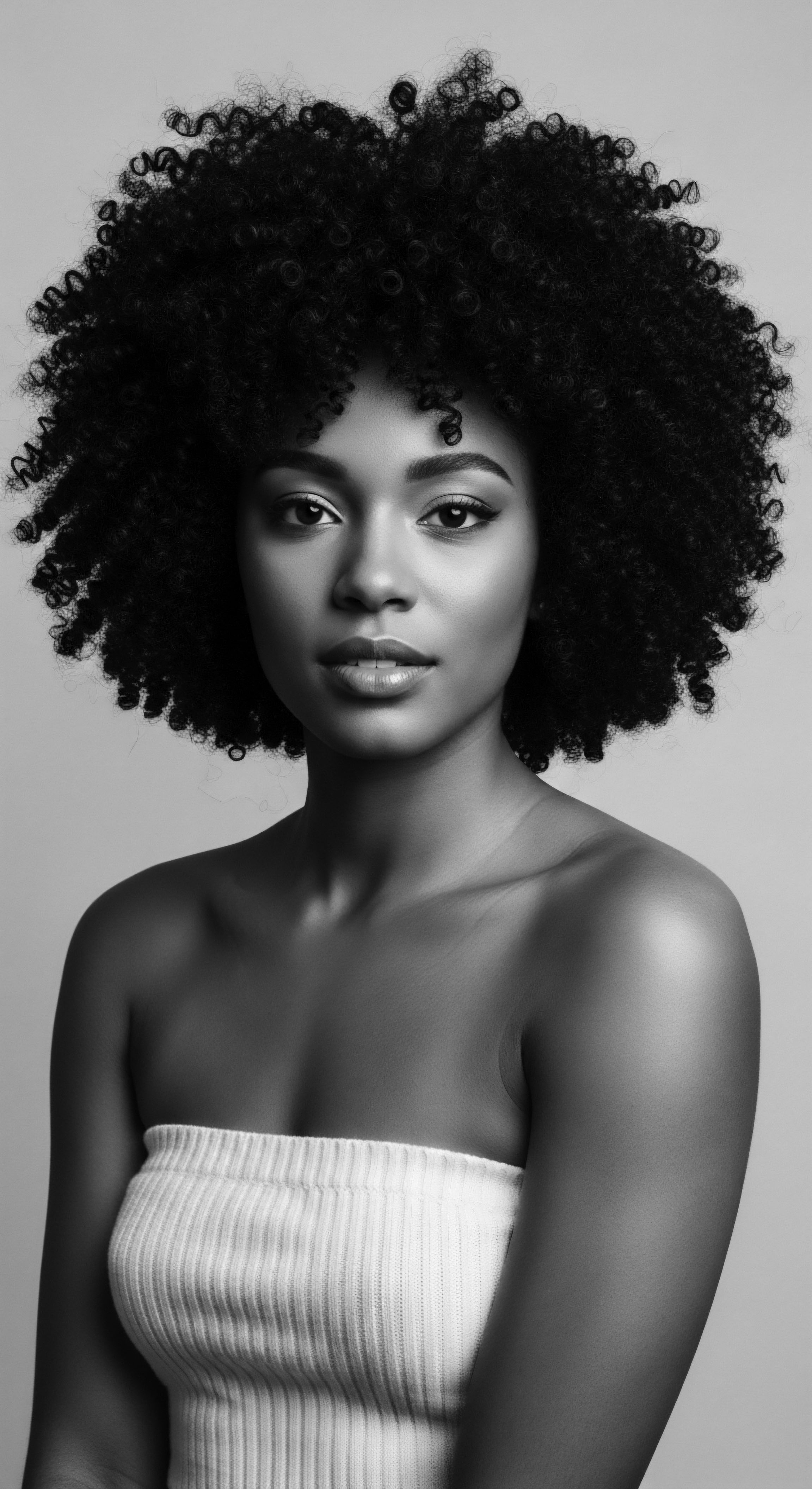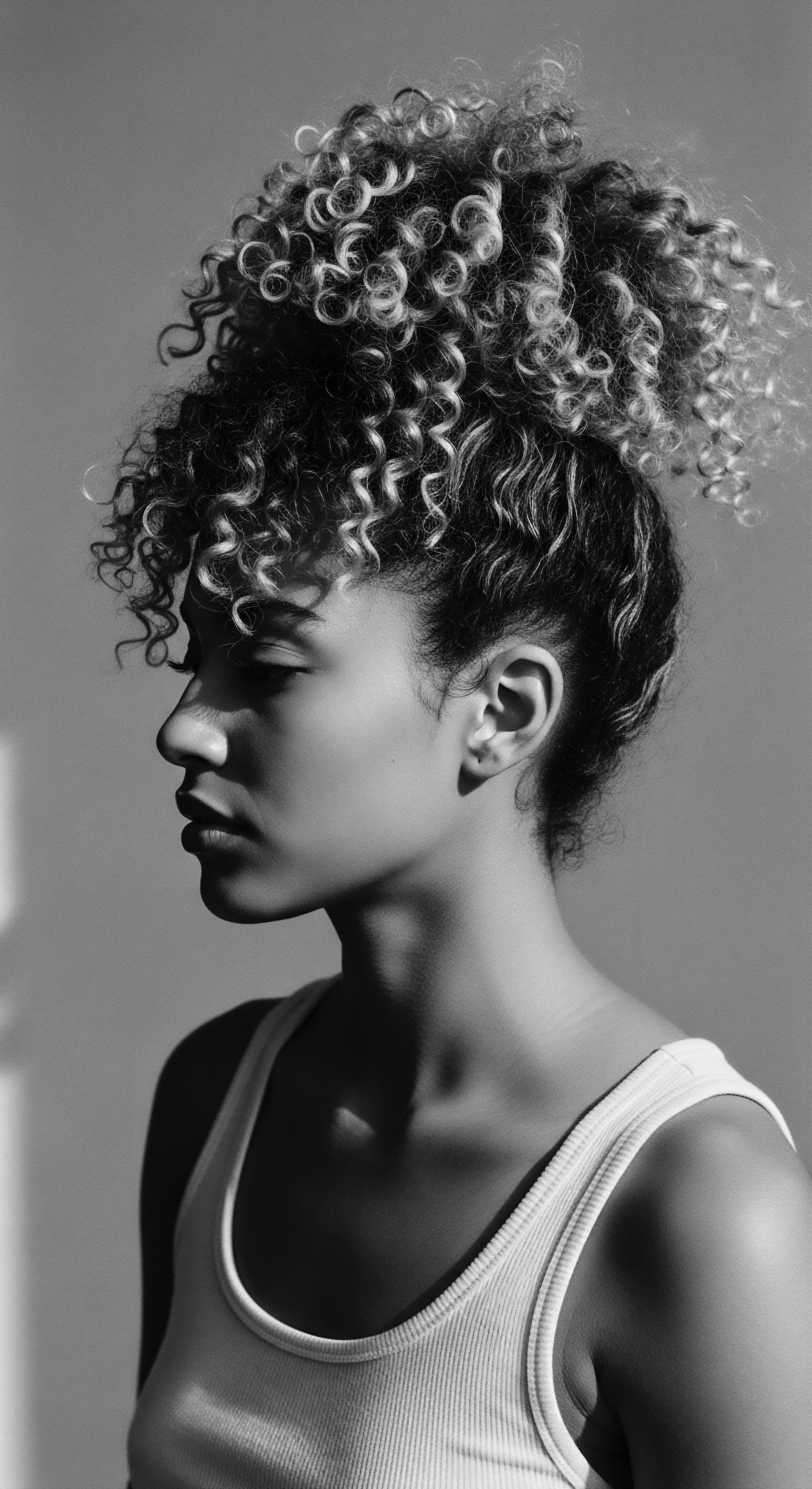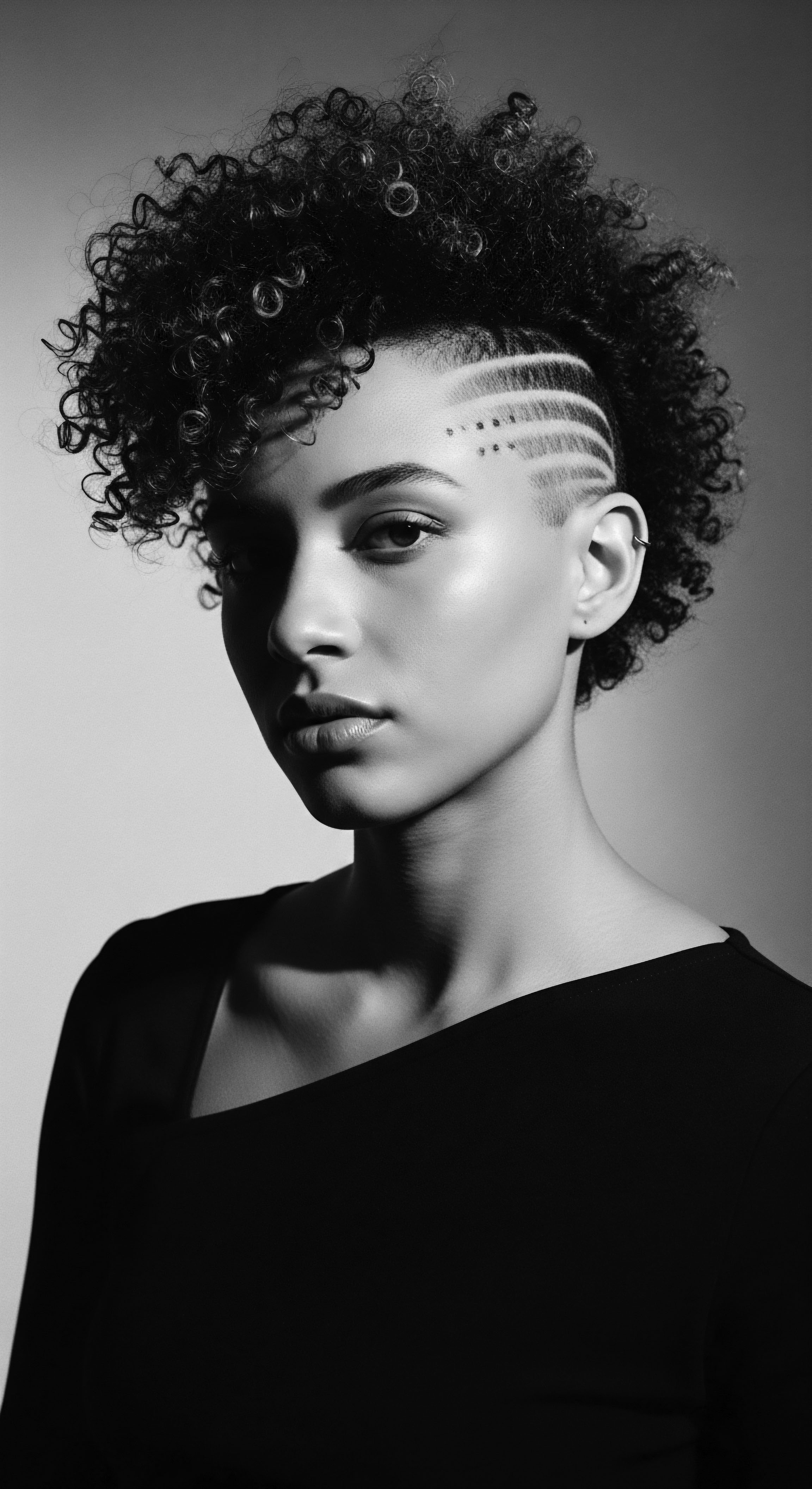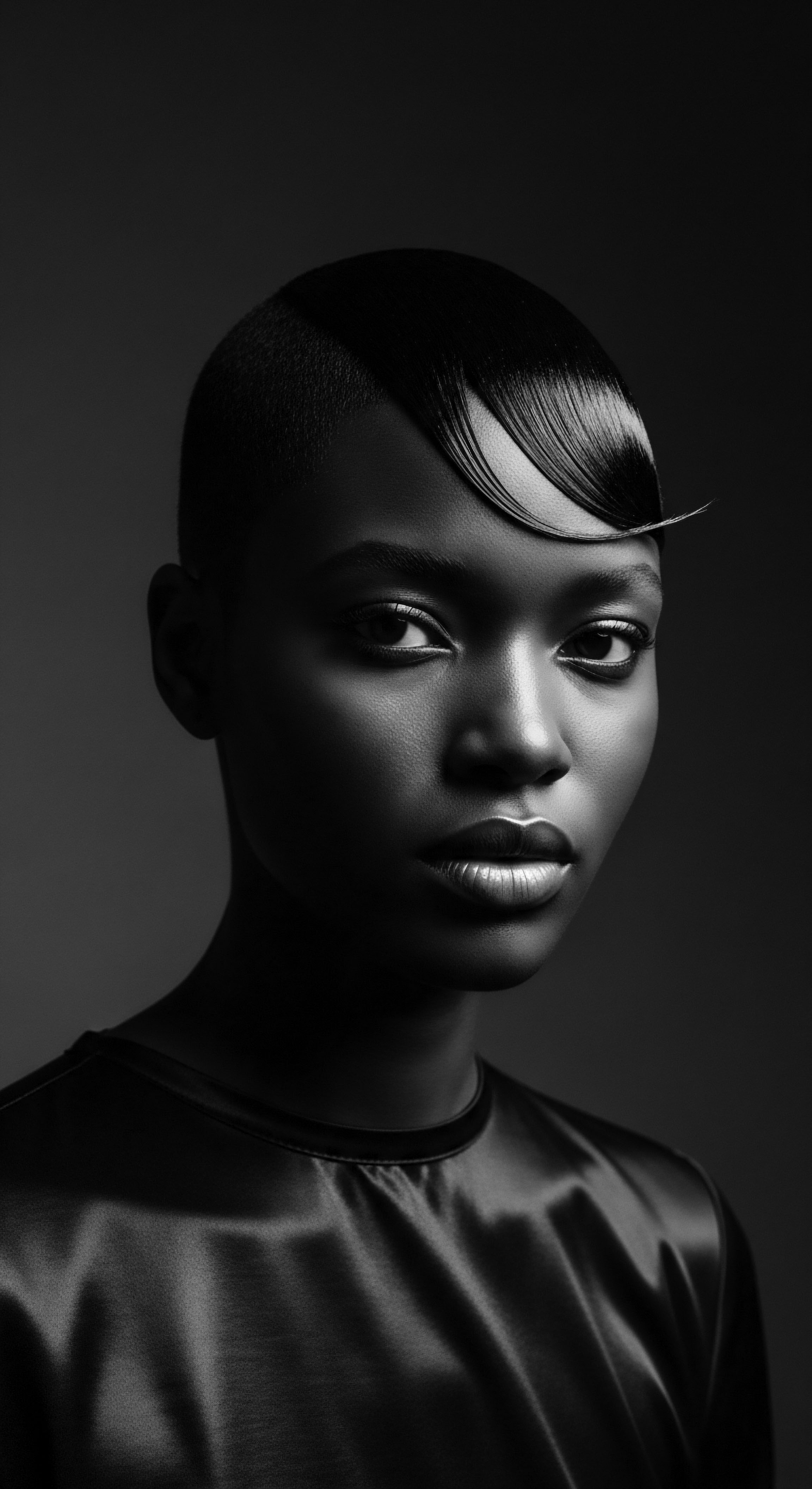
Roots
To stand on this ground, to speak of hair, is to remember the whispers carried on the wind from generations past. For those of us walking with the spirit of Roothea, the very fibers that spring from our scalps are not merely strands of protein; they are living archives, imbued with the stories of survival, resilience, and unyielding beauty. When we ask how the wisdom of ages connects to the needs of textured hair today, we begin by listening to the soil from which our understanding grows.
This inquiry is an invitation to witness the profound intimacy between biology and belief, between a curl’s inherent structure and the ancestral hands that nurtured it. It is a dialogue with time, a sacred conversation between yesterday’s knowledge and tomorrow’s possibilities, all spiraling from the enduring heart of our heritage.

Hair’s Ancient Blueprint
Consider the very composition of textured hair, its unique helical twists and turns, each curve a testament to a journey millions of years in the making. From a biological standpoint, textured hair, whether coiled, curled, or wavy, presents a distinct morphology ❉ an elliptical follicle, a cuticle that often lifts more readily, and points of curvature that can create areas of structural weakness. These characteristics, often viewed through a narrow lens in contemporary discourse, were implicitly understood by our forebears.
Long before microscopes revealed cellular structures, the practical knowledge of hair’s fragility at its bends, its thirst for moisture, and its tendency to tangle was not lost. This was not abstract science; it was an intuitive knowing, passed down through the daily acts of tending.
The anatomy of textured hair, with its diverse curl patterns, presents a biological marvel. The cortical cells within a highly coiled strand are not uniform, creating tension at each curve. This tension explains why textured hair can be more prone to breakage if not handled with profound care. Historical practices, seemingly simple, were often complex responses to these inherent biological realities.
Think of the deliberate gentleness applied during detangling with fingers or wide-toothed tools carved from wood or bone. This gentle approach prevented fracture at those vulnerable points, an early form of protective styling that predated our scientific nomenclature.
The story of textured hair is written in its very structure, a biological blueprint echoing ancestral wisdom on care.

Language of the Strand
The words we choose to describe hair hold significant weight, particularly when tracing its heritage. Modern classification systems, like those using numbers and letters to categorize curl patterns, offer a convenient shorthand for commercial purposes. Yet, they sometimes fall short in capturing the spirit and diversity of textured hair, often originating from perspectives that did not fully appreciate its breadth. Historically, communities held their own lexicons, terms that spoke not only to appearance but to significance, lineage, and spirit.
- Tresses ❉ A poetic term historically used to describe long, flowing hair, often implying beauty and strength. In many African cultures, long hair was a sign of fertility, wealth, or status.
- Locks ❉ Beyond the modern dreadlock, ‘locks’ in historical contexts could refer to any distinct, matted, or braided sections of hair, deeply tied to spiritual or communal identity.
- Crown ❉ This term, widely used in Black and mixed-race communities today, elevates hair to a symbol of royalty, dignity, and personal power, reflecting its historical significance as an integral part of identity and spirit.
These terms, some ancient, some evolving, speak to a deep reverence. The ancestral understanding of hair as a conduit for spiritual connection or a marker of tribal affiliation shaped the language used to describe it, far beyond mere texture. When a community referred to specific hair arrangements as symbols of mourning, celebration, or passage, they imbued those styles with a living, breathing vocabulary of meaning. This rich heritage of nomenclature reminds us that how we speak about our hair directly influences how we perceive and care for it.

Cycles of Life and Growth
The rhythmic dance of hair growth, its anagen, catagen, and telogen phases, is a universal biological process. However, environmental factors, nutritional landscapes, and communal practices historically played a profound role in influencing these cycles for textured hair. In environments where access to clean water was limited, or where diets were rich in certain indigenous plants, hair care evolved to maximize retention and minimize disruption.
Consider the impact of climate. In many parts of Africa, the intense sun and dry winds necessitated protective measures for hair. Ancestral practices like heavy oiling with plant-based emollients, or elaborate braiding that kept strands tucked away, served as effective barriers against environmental stressors.
These were not simply aesthetic choices; they were pragmatic responses to the elements, deeply informed by observation and the shared wisdom of generations. The very factors that influence growth and health today – diet, hydration, protection from damage – were understood and addressed through ingenious methods long ago, underscoring a continuous lineage of care.

Ritual
The care of textured hair, at its soul, has always been a ritual. It is a deliberate, often communal act, steeped in the art of technique and the quiet science of transformation. Across continents and through centuries, ancestral hands sculpted, adorned, and safeguarded hair, creating practices that speak directly to the very needs we seek to address today. This heritage of styling extends beyond mere aesthetics; it is a profound articulation of identity, status, and protection, a living record of ingenuity.

Protective Styles Through Time
From ancient Kemet to the intricate designs of West African empires, protective styles formed a cornerstone of hair care. These were not fleeting trends; they were architectural masterpieces designed to shield delicate strands from environmental aggression, minimize tangling, and promote length retention. The plaiting, braiding, and coiling seen in historical depictions – often embellished with cowrie shells, beads, or precious metals – served a dual purpose ❉ spiritual and practical.
The techniques themselves, such as cornrows (known by various names across different cultures, including ‘canerows’ in the Caribbean), box braids, and intricate twists, prevented the daily manipulation that leads to breakage. These styles allowed hair to rest, to gather its strength, and to retain moisture for longer periods. This knowledge, passed down through oral tradition and hands-on teaching, provided a systemic approach to hair health.
The modern resurgence of protective styling, therefore, is not a new invention. It is a powerful affirmation of ancestral wisdom, a homecoming to methods proven effective over countless generations.
Ancient protective styles were more than adornment; they were sophisticated engineering for hair preservation.

Handwork and Definition
The art of natural styling, of coaxing definition from each coil and curl, finds deep roots in historical practices. Long before gels and custards, plant-based preparations were utilized to enhance curl patterns and provide hold. Extracts from leaves, barks, or seeds, often rich in mucilage or natural oils, were applied to hair, demonstrating an empirical understanding of how to encourage clumping and reduce frizz.
Consider the rhythmic hand movements employed during these applications – the careful sectioning, the twisting, the palm-rolling – all designed to align the hair’s natural pattern. These methods, often performed as shared community experiences, built a collective knowledge base of what worked for different hair types within a family or village. This hands-on, intuitive approach to curl definition speaks to a deep connection with the hair’s inherent characteristics, an intimacy that modern hair care often seeks to replicate with its array of products and techniques. The goal remains consistent ❉ to reveal the innate splendor of textured hair.

Tools of the Artisan
The tools of ancestral hair care, though simpler in form, were refined through centuries of use, perfectly adapted to the needs of textured hair. Unlike modern mass-produced implements, traditional tools were often crafted with intention, from natural materials, and designed for longevity and gentleness.
| Traditional Tool/Method Wide-Tooth Wooden Combs (carved from local hardwoods) |
| Modern Analogue/Purpose Detangling, minimizing breakage, distributing products gently. |
| Traditional Tool/Method Fingers and Bone Picks |
| Modern Analogue/Purpose Gentle sectioning, detangling, lifting roots, styling intricate patterns. |
| Traditional Tool/Method Clay, Plant Pastes, & Oils |
| Modern Analogue/Purpose Conditioning, moisturizing, providing hold, scalp treatment. |
| Traditional Tool/Method Hair Pins & Ties (made from natural fibers or leather) |
| Modern Analogue/Purpose Securing styles, holding hair in place, protective bundling. |
| Traditional Tool/Method The continuity of purpose behind ancient and modern tools underscores timeless hair care principles rooted in heritage. |
These tools were extensions of the hands that wielded them, instruments of both utility and expression. The knowledge of which wood to use for a comb to avoid snagging, or how to prepare a plant extract for optimal slippage, was part of a generational inheritance. Modern hair care tools, while technologically advanced, often strive to replicate the efficacy and gentle touch of these historical implements. This continuity underscores the enduring principles of care that remain at the heart of maintaining textured hair, a testament to the wisdom that crafted even the simplest comb.

Relay
The relay of wisdom across generations forms the very backbone of textured hair heritage. It is here, in the exchange of knowledge from elder to youth, that ancestral practices seamlessly intersect with modern scientific understanding, revealing deep truths about holistic wellbeing. This section analyzes the complexities of how historical hair care wisdom connects to modern textured hair needs, drawing on research and scholarship to highlight the enduring relevance of these traditions.

Anointing with Earth’s Bounty
The use of natural ingredients for hair care, a practice deeply ingrained in ancestral traditions, often finds its validation in contemporary scientific study. Consider the Himba women of Namibia, whose distinctive appearance is defined by their ‘otjize’ paste. This rich, reddish mixture of butterfat, powdered ochre, and aromatic herbs is applied to their skin and elaborate hair braids daily. Historically, this practice served far more than an aesthetic purpose.
The butterfat, typically derived from cow’s milk, acts as a potent emollient, deeply moisturizing the hair and scalp, which is especially vital in the arid Kunene region. The ochre provides natural sun protection, shielding the hair and skin from the harsh African sun’s damaging UV rays, a property now understood through modern photoprotection research. Furthermore, the herbs infused within the mixture likely contributed antimicrobial or soothing properties for scalp health (Fleisher & Fleisher, 2011, p. 115). This sophisticated, multi-purpose regimen, developed empirically over centuries, directly addresses modern textured hair needs for deep conditioning, UV protection, and scalp health, showcasing an unparalleled ethnobotanical wisdom that precedes formal scientific inquiry.
Ancestral ingredient wisdom, like the Himba’s otjize, offers profound lessons for modern hair needs.
The relay of such knowledge, though often unwritten, ensured that essential practices for hair vitality persisted. Ingredients such as shea butter, argan oil, coconut oil, and various plant extracts, now staples in contemporary hair products, were revered in ancestral contexts for their specific properties ❉ their ability to seal moisture, soothe inflammation, or strengthen strands. Modern cosmetic science has isolated the fatty acids, vitamins, and antioxidants in these botanicals, providing molecular explanations for the efficacy observed by generations of practitioners.

Nighttime Sanctuaries and Bonnet Wisdom
The practice of protecting textured hair during sleep, a cornerstone of modern regimens for moisture retention and breakage prevention, echoes deeply ingrained historical precedents. While the satin bonnet or silk scarf may seem like contemporary innovations, their underlying purpose – to create a gentle, friction-free environment for hair – has been a constant.
Historically, various forms of head coverings were used for hair preservation and protection during rest. From wraps made of woven fibers to more intricate cloth constructions, these coverings prevented hair from drying out overnight, minimized tangling from tossing and turning, and maintained the integrity of delicate styles. The wisdom lay in understanding that night, a period of rest for the body, could also be a period of vulnerability for hair, particularly for textured strands prone to moisture loss and friction damage. This continuity demonstrates how ancestral ingenuity, driven by pragmatic observation, directly informs one of the most vital modern care practices for healthy hair.
The transition of these practices from necessity to intentional ritual reflects a deep understanding of hair’s needs. Communities in the African diaspora, facing new climates and challenges, adapted these protective measures, transforming them into symbols of self-care and continuity. The ‘bonnet wisdom’ of today, passed down from grandmothers to granddaughters, is a direct inheritance from those who understood that true hair vitality begins even as one dreams.

Can Ancestral Wellness Philosophies Shape Current Hair Health?
Beyond individual ingredients or techniques, ancestral wellness philosophies offer a profound framework for understanding hair health holistically. In many traditional African and diasporic cultures, the body, mind, and spirit are seen as interconnected. Hair, as the ‘crown,’ was never isolated; its condition was often seen as a reflection of overall wellbeing. This perspective offers a powerful counterpoint to a fragmented, product-centric approach to modern hair care.
Consider the emphasis on internal nourishment through diet, stress reduction through communal support, and the spiritual significance of hair adornment or cutting ceremonies. These were not just ‘add-ons’ to hair care; they were integral to it. A balanced diet rich in local, nutrient-dense foods (e.g.
leafy greens, root vegetables, protein sources) naturally supports keratin production and scalp health. Communal hair sessions, beyond their practical function, offered psychological and social benefits, reducing stress and fostering a sense of belonging, both of which impact physiological processes, including hair growth.
Modern science is increasingly validating the gut-brain-skin axis and the impact of stress on hair loss or poor hair condition. This emerging understanding mirrors what ancestral wisdom intuitively grasped ❉ that true radiance emanates from within and is cultivated through a harmonious relationship with oneself and one’s community. Integrating this holistic worldview into contemporary textured hair care means looking beyond topical solutions to embrace nutrition, mental wellbeing, and connection to heritage as equally vital components.

Reflection
The journey through textured hair heritage, from the fundamental structure of each coil to the intricate rituals of communal care, reveals a profound truth ❉ the wisdom of the past is not a relic; it is a living, breathing guide. Our exploration into how historical hair care wisdom connects to modern textured hair needs unveils a lineage of ingenuity, observation, and deep reverence for the strands that grace our crowns. The ‘Soul of a Strand’ whispers of ancestral hands, of remedies culled from the earth, and of styles that spoke volumes without a single word.
We stand at a unique junction where scientific inquiry meets timeless tradition. The patterns observed by our forebears, the plant-based solutions they perfected, the protective gestures they instinctively understood—all find echoes, and often validation, in the laboratories and product innovations of today. This is not a matter of simply revisiting the past; it is about recognizing that the solutions we seek for healthy, thriving textured hair often lie embedded within the very heritage we carry.
To truly understand our hair today, to nurture it with intention and intelligence, requires us to listen deeply to the echoes from the source, to honor the tender thread that connects us to ancestral wisdom, and to recognize the unbound helix as a symbol of enduring identity and ever-unfolding possibility. The legacy of textured hair is one of beauty, resilience, and an unbroken chain of knowledge, waiting to be rediscovered and celebrated with every gentle touch.

References
- Fleisher, M. L. & Fleisher, M. S. (2011). The Himba ❉ Pastoral Herders of Namibia. University of Washington Press.
- Ayodele, O. (2007). Traditional African Hair Practices ❉ A Cultural and Historical Perspective. Journal of Black Studies.
- Chou, J. S. (2014). The Science of Hair Care. Elsevier.
- Gabay, C. (2018). Hair as a Social and Cultural Barometer ❉ Afro Hair and Identity. Taylor & Francis.
- Powell, L. G. & Smith, C. M. (2009). African American Hair ❉ Cultural Identity and Self-Esteem. Guilford Press.
